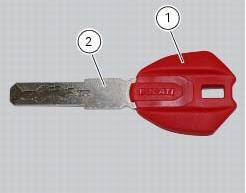
Ducati Diavel Service Manual: Passive key
Introduction
The passive key (1) is used when the active key is not working correctly or is not available.
The passive key works as a transponder, and must therefore be placed physically onto the antenna to work.
The mechanical part (2) of the key is used to open the seat or the tank plug.

Wiring diagram
No wiring diagram is available for the component
Error codes
"Key diagnosis" error: "wrong key". The key has been detected but is not associated with the hands free system. The fault can only be viewed from the dds after switching the dashboard on with the pin code.
- Check that the key is correct.
- Reprogramme the key
- If none of the tests described above identify the problem, replace the hands free system
"Key diagnosis" error: "encryption error". The encrypted code stored in the key is not recognised by the hands free system. The fault can only be viewed from the dds after switching the dashboard on with the pin code.
- Check that the key is correct.
- Check that the key is not damaged.
- Check that the antenna is working correctly.
- Reprogramme the key
- If none of the tests described above identify the problem, contact ducati
Electrical characteristics and checking component
The component has no specific electrical characteristics and requires no special checks.
In the event of fault
In the event of a fault, try reprogramming the key.
Component replacement methods
The component does not require replacement.
 Active key
Active key
Introduction
The active key (1) communicates with the hands free system by radio. In order
to function, the key must be within a 1.5
Metre radius from the antenna (located in the document compartm ...
 Programming/reprogramming keys
Programming/reprogramming keys
The dds diagnosis instrument is required in order to programme/reprogramme
the keys. The key programming procedure
is launched from this instrument.
To start the key programming/reprogramming pr ...
Other materials:
Reassembly of the gearbox
To refit the gearbox components follow the procedure under sect. 9 - 9.2,
Reassembly of the crankcase halves, relating to
reassembly of the engine crankcase.
As a final practical test, ensure that with the gearbox in neutral the front
coupling dogs (a) of sliding gears (b) are
equidistant o ...
Battery voltage indicator (battery)
This function describes the battery voltage indicator.
To access the function it is necessary to view the "setting" menu page 48, using
button (1, fig. 14) ?"" or (2, fig.
14) ?" " select the "battery" function
and press the reset
button (12, fig. 12 ...
Refitting the engine
Refitting is the reverse of removal.
Important
Apply recommended grease and tighten the special screws (6) to a torque of
60 nm +/- 5% (sect. 3 - 3, Frame torque
settings).
Tighten the nuts (3) to a torque of 48 nm +/- 5% (sect. 3 - 3, Frame torque
settings).
Warning
For the assembly seque ...